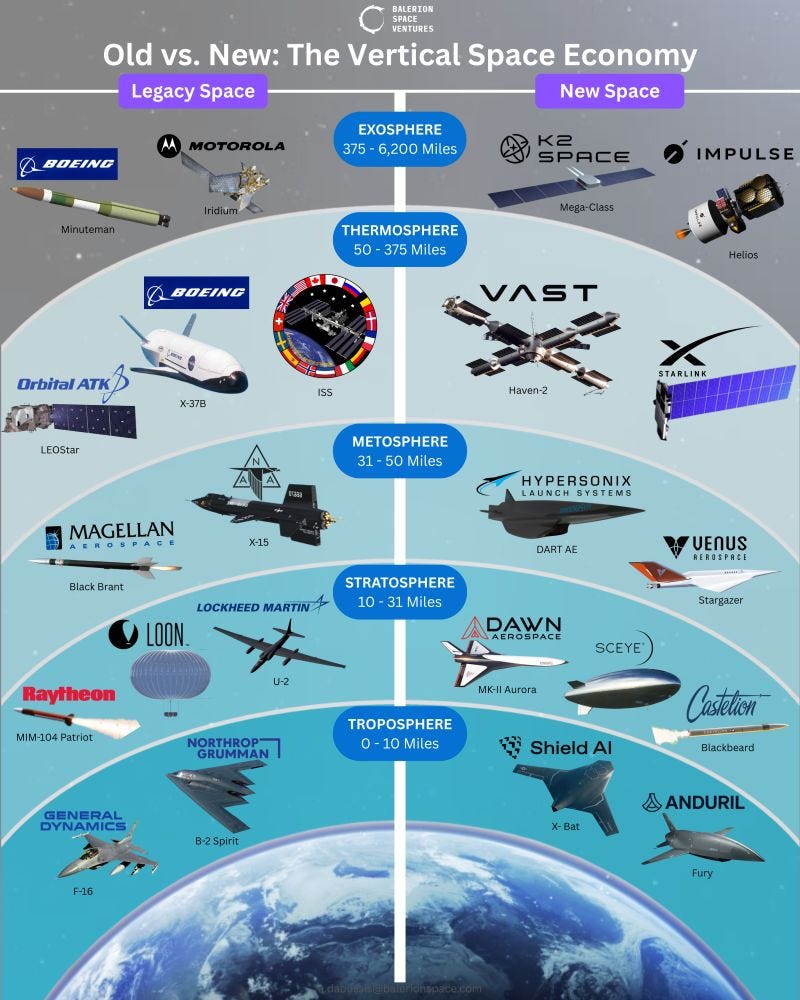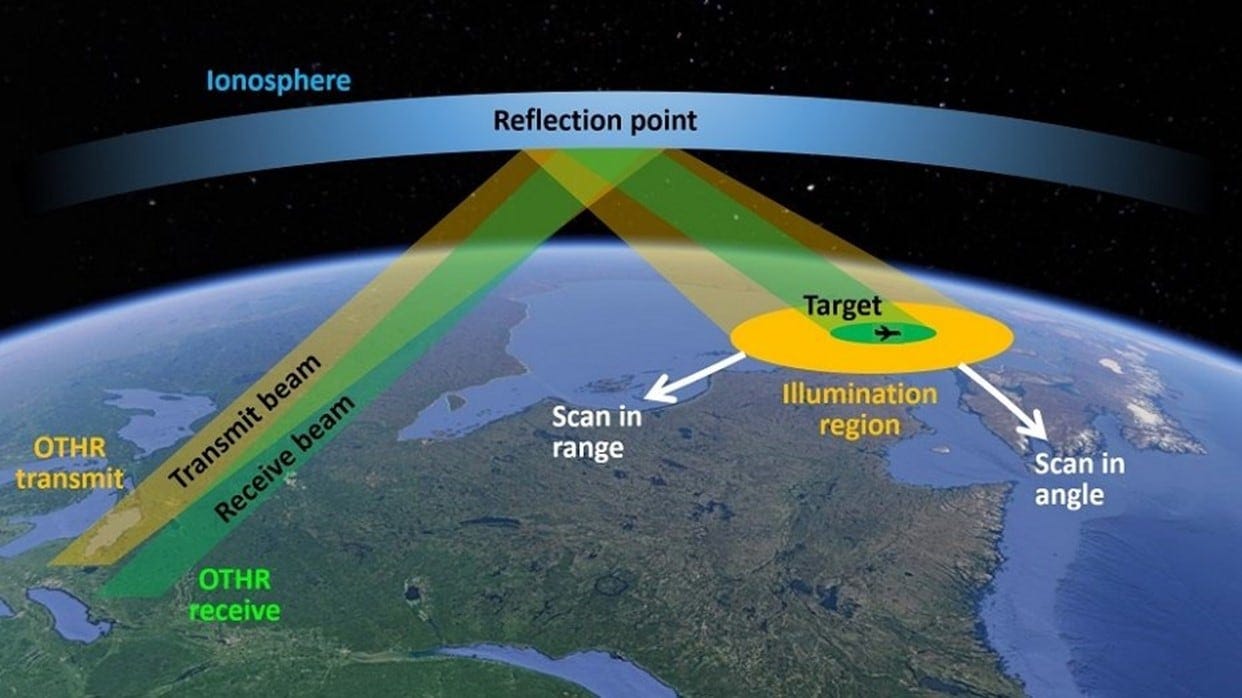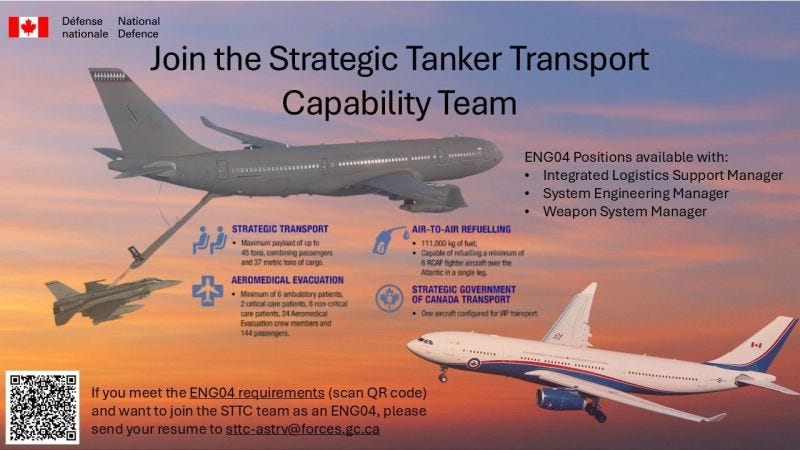Space race heats up
Canada’s space industry wants $7.5B in defence dollars
🎯 Three-Shot Burst
Canada’s space industry is jockeying for a chunk of the federal government’s defence dollars, selling itself as a sector that’s critical to national security and, quite possibly, the first frontier for Canada in any impending conflict.
According to a new report by Royal Bank of Canada titled A Higher Orbit, this could inject $7.5-billion annually into the Canadian space sector:
The global space economy is expected to nearly triple to US$1.8-trillion by 2035, according to RBC’s report. As part of that, Canada has an opportunity to grow its domestic space industry four-fold to $21-billion in the next 10 years. But only if it can attract $12-billion in public and private capital to spur this growth, RBC writes.
Related:
Rocket launch proves to be a milestone for budding Nova Scotia spaceport… Space Race With China Drives Antenna-Building Boom in Arctic… Luxembourg Space Agency awards contract to CSMC to Advance Quantum Sensing for Resource Exploration… Wyvern’s Kurtis Broda on the growing space economy… Canada investing more than $500 million in European Space Agency programs
Founders will miss out on “10x” their valuation if they don’t lean into the defence trend, according to Pekka Laurila, cofounder of Finnish spacetech and dual use startup Iceye… French Rocket Builder HyPrSpace Secures €21 Million in New Funding… Quindar Raises $18M Series A to Accelerate the Next Generation of U.S. Mission Control
Canada’s new defence-procurement body represents an acknowledgement that its existing defence-procurement system cannot keep pace with current international challenges and the rate of defence-relevant technological change. It also represents a gamble
Seeing double: Trade tribunal urges feds to redo multimillion-dollar defence bid after ‘valid’ complaint it favoured U.S. supplier
Defence focus in budget signals turning point, but some defence experts wary about lack of detail
At the Halifax International Security Forum, Republican lawmaker Sen. Thom Tillis of North Carolina says it’s all good and well that Canada is finally meeting its NATO defence spending commitments, but Canada should make up for two decades of back dues — to the tune of $300 billion
Looming military radar project creates deep anxiety for rural Ontario community:
If Ukraine is defeated, Canada risks being squeezed between two emboldened, expansionist neighbours
Stockpile: Canada has designated our critical minerals essential to national defence under the Defence Production Act. Per sections 12-14 of the Act: the sweeping powers could range from simply reports from the sector on capacity, to stockpiling and/or investment or direct ownership to secure supply
All U.S. Critical Minerals in 2025, Ranked by Supply Disruption Risk
ADVERTISEMENT
Dominion Dynamics is expanding our team and we’re looking for ambitious Canadians who want to build sovereign technology for the future of national defence.
Join NGen at Hannover Messe 2026 – The Global Stage for Advanced Industrial and Defence Solutions
This is your chance to showcase dual-use industrial & defence applications with team Canada at the world’s largest industrial show – the perfect platform to connect your innovations with global buyers, partners, and investors.
Register through NGen to secure your spot in the official Canadian Pavilion and:
Showcase your tech to 200,000+ international decision-makers
Access high-value leads in defence, aerospace, and dual-use markets
Claim reimbursement up to $10,000 per company for eligible costs
Limited exhibitor spaces – apply now!
Contact NGen to reserve your place in Canada’s premier delegation.
🤝 Deal Corner
First Person POV by OnDeck AI CEO Alexander Dungate:
Singapore Is Beating Canada to Canadian Defence Tech
The Singapore military came to our living room and set a gold standard for defence tech procurement with a simple trick: open lines of communication and spot contracting.
While our team was going through Y Combinator this summer, executives from Singapore’s Defence Science and Technology Agency (DSTA) got wind of what we were building at OnDeck AI and asked if they could come by to get to know our technology and our team.
They shared their challenges over tea, tried our product on live data, murmured excitedly, then they typed up a contract right there on our dining room table. Today our collaboration has grown across several branches of the Singapore Armed Forces, and we have developed the type of relationship that I hope to see the Canadian Armed Forces build with other startups in Canada.
Singapore recognises that startups often outpace incumbents on innovation and they have developed a procurement strategy that lets them stay abreast with frontier capabilities from startups. Their approach is simple:
Open casual lines of communication with startups.
Bring budget to the table with spot contracts (signed in minutes).
Move on startup timelines (days and weeks, not months).
In Canada, the request for proposal (RFP) process effectively blocks the Armed Forces from having access to the latest capabilities from startups. While programs like IDEaS and Innovative Solutions Canada exist to help the CAF engage with innovation, unfortunately both programs still flow through rigid RFPs, run on multi-year timelines, and are misaligned from how good startups work.
Most crucially, there is no official path for members of the CAF to talk with startups to share their needs, learn about new capabilities, and mutually explore what solutions could look like for their problem space.
It takes months to years for a need in the CAF to be expressed as an RFP, then additional months to years for responses and contracting. At best, this means solutions will be a year out of date by the time they are delivered. In the age of AI, this means solutions for our Forces will be archaically out of date.
Startups outpace incumbents by obsessing over a user’s problem and moving incredibly quickly. By enabling the user engagement and speed, Singapore (along with the US), are able to capture the unique edge found in startups to give their forces superior capabilities. With the frenzy around modernizing defence procurement, I am optimistic that this may be a time for our Armed Forces to unlock the same capabilities.
Related:
David Ulevitch on Building a16z’s Hottest New Fund
Backed by Canadian VC: The Strange and Totally Real Plan to Blot Out the Sun and Reverse Global Warming… Defence Minister McGuinty hosts VC roundtable with defence industry stakeholders… ‘Very exciting time to be investing’: A deep dive into the promise of Canadian defence tech
Klaus Hommels: the divisive VC at the centre of European defence tech
German drone maker Quantum Systems is about to close a €200m round at a $3bn valuation… Cyber specialist Method Security raises $26 million
Since 2019, over 1.7 billion dollars have been invested in Nordic defence tech companies
Amsterdam-based Keen raises €150M to back defence tech in Europe
Brussels slashes €6.7bn price tag for UK to join EU defence fund
Rift Raises €4.6M to Build European Network for On-Demand Aerial Intelligence
Investing at the Edge: Venture Capital and the Future of Defence Innovation… The US Navy’s plan to stand up a new Unmanned Acquisition Office (potentially consolidating up to 66 unmanned programs across six PEOs) is a major signal in the ongoing transformation of the defence acquisition landscape
Europe Needs New Industrial Priorities To Deliver On Defence Pledges… BCG on how to make money building ships
Silicon Valley’s defence-first history:
This first generation of the Valley “seeded companies that repurposed technologies built for war to everyday life,” writes Margaret O’Mara, a tech industry historian. “Today’s tech giants all contain some defence-industry DNA.”
ADVERTISEMENT
⚔️ Combat Readiness
Drone dominance as a proxy for techno-industrial superiority
With the rise of techno-industrial warfare and far-reaching hypersonic missiles, it is increasingly argued that strategic depth is not just confined to terrain or the geography of a map. It is the ability to achieve self-sustainment in a protracted conflict. And it is increasingly an area where allied strength is at risk.
A suitcase-sized drone slips into the airspace above a U.S. military base. Operations grind to a halt. Security forces scramble, but the damage is already done — all caused by a device that costs less than a smartwatch.
The Pentagon’s growing list of ‘made in America’ drones has a loophole for certain parts made in China. China’s emphasis on manufacturing, while perhaps not economically efficient, has also probably prepared it better for prolonged capital-intensive war:
‘China was playing chess while the rest of us were playing checkers’: Bombshell study finds $200 billion of secret loans to U.S. businesses over 25 years
The US Defense Innovation Unit (DIU) announced the selection of six companies to advance under Project G.I., Design Reference Mission 2 (DRM2) – a Prize Challenge focused on accelerating the kill chain for small, expeditious units in denied environments.
The UK MoD confirms their DragonFire laser shoots down high‑speed drones traveling at 400mph, costs $13 per shot — UK Navy to begin deploying system on destroyers.
Meanwhile on our side of the border:
Here’s what DARPA is actively funding inside the U.S. SBIR program.
Related:
Canada delivers 25 M113 APCs and air-to-air missile components to Ukrainian forces… An analysis of the global drone market after the war in Ukraine
Deloitte Invests in Kihomac to Rapidly Scale US-Made Drones… The Case for Treating Drones as Ammunition… Collaborative Combat Aircraft: All Speed and No Direction
AGI Delusion: By Chasing Superintelligence, America Is Falling Behind in the Real AI Race
Kaboom: New Canadian firm and France’s Eurenco plan explosives factory in Canada to meet NATO demand… During World War 2, IBM Canada established a special “Defence Plant” in West Toronto, where employees produced precision instruments to support the Allied effort
Dogfight: Canada is shopping for new fighter jets—and on the verge of making a disastrous decision… Sweden offers Canada a chance to revive its near-dead defence aerospace industry… The idea of a mixed fleet of Canadian fighter jets should not take flight… Canada ‘interested’ in Swedish firm Saab’s Gripen fighter jets… Saab says Canada’s air force could have Gripen fighter jets in as little as 3 years… U.S. ambassador calls F-35s ‘phenomenal success’ as Canada considers Swedish fighter jets… Gripen vs. F-35 — is it about the jet or the jobs? It depends.
Canada’s Fighter Debate Misses the Point: It’s Time to Build, Not Buy
Dogfight… in the water?: Canada’s instructions to submarine contract bidders highlight sustainment, economic benefits
Dish it: COVE to pilot Canada’s first Defence Innovation Secure Hub (DISH), the inaugural project under BOREALIS
Call of Duty: UK MoD to launch esports tournament pitting Britain’s ‘future cyber warriors’ against military teams from 40 other countries
Power moves: Canada is an agriculture and food superpower. We must start acting like it… Canada needs to step up. We need CANDU nuclear technology… Canada’s dual-use moment and how local startups are securing the future of critical infrastructure
Call me maybe: Digital Sovereignty in Mobile Wireless Networks: Why It Matters Now More Than Ever… Okta to launch Canadian data cell as sovereignty debate intensifies
Could This Humanoid Robot Become the Army’s Ultimate Warrior?
The surreal 45-day trek at the heart of NATO’s defence
ADVERTISEMENT
Barrack Hill: Navigating Canada’s defence and procurement landscape with precision.
🔫 Hot Shots
Grey war: The cyberattacks are coming… The Pentagon Can’t Trust GPS Anymore. Is Quantum Physics the Answer?… U.S. National Cyber Strategy will shift from primarily focusing on online defences to actively going after nation-state hackers to deter attacks before they happen… Amazon warns of global rise in specialized cyber-enabled kinetic targeting… China Is Winning the Cyberwar… How to know if your Asus router is one of thousands hacked by China-state hackers… Can Chinese-Made Buses Be Hacked? Norway Drove One Down a Mine to Find Out… MoD tells staff not to discuss secrets in cars amid China spying fears
Compute: Could Compute Become a Commodity? Lessons from Oil, Power, and Spectrum… Canada’s digital sovereignty is crumbling under aggressive U.S. lobbying
Bad kids table: Drones: Decoupling Supply Chains from China… Beijing’s blueprint for breaking Canada-U.S. unity… China has ramped up its support for Russia to hammer Ukraine… What to know about China’s newly modernized nuclear arsenal… Russian Spy Ship Breaches Allied Waters, Fires Lasers at Military Planes… China’s New Tailless Stealth Fighters Both Appear At Secretive Test Base… A detailed Russian training manual on UAVs in modern combat… China has quietly announced 43 companies to build biomanufacturing pilot plants by 2027
Beefed up: TACTIQL welcomes CAF veteran Patrick Twomey as Chief of Staff… Transferring aircraft will help Ottawa meet NATO’s new spending target… Top general plans sweeping expansion of reserves for disasters, military attacks… Ottawa expects private cash to play role in northern infrastructure… Canada, U.S., Finland outline plan to build new icebreakers… Cool job alert:
If you’ve got battlefield intel, classified tips, or just want to call in an airstrike on our typos, hit “reply” and sound off. Whether it’s a new tech sighting, a rumour from the mess hall, or feedback on our comms, we want your SITREP.















